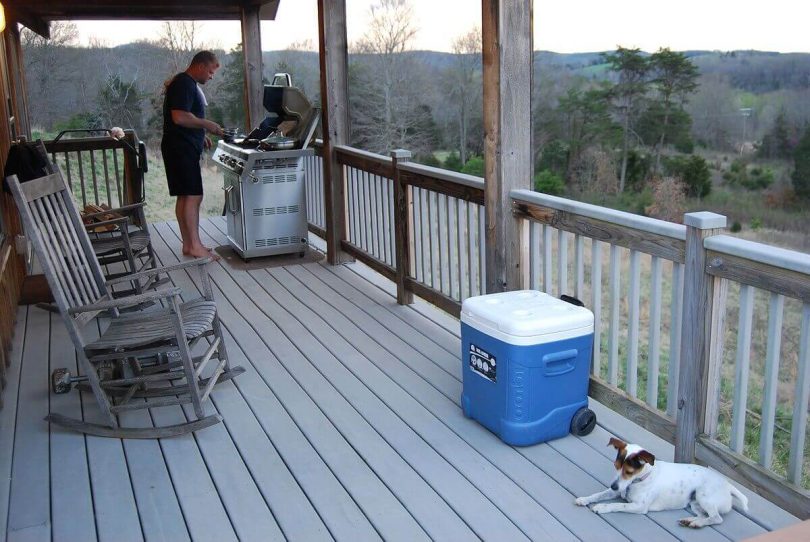Picture this: a warm summer evening, the sun is setting, and the smell of sizzling burgers and juicy steaks fills the air. But what if you don’t have a backyard or patio to grill on? Fear not, because in this article, we’ll be discussing the ultimate guide to grilling on a screened in porch.
Whether you’re in an apartment or a house with limited outdoor space, a screened in porch can be the perfect solution for enjoying the great outdoors while still being protected from the elements.
We’ll cover everything from safety tips to the best grills for a screened-in porch, so you can create the ultimate outdoor cooking experience without ever leaving your home. Get ready to grill up a storm and enjoy delicious meals with family and friends all summer long!
Safety Precautions
In this section, we’ll explore the different factors you should consider when deciding whether or not to put a grill on your screened-in porch.
Fire Safety
Grilling on a screened-in porch can be dangerous. It is essential to consider the risk of fire when using a grill in an enclosed area. A grill generates heat, and if there is not enough ventilation, it can cause a fire. The heat generated from the grill can also cause the surrounding materials to catch fire.
To reduce the risk of fire, it is recommended that you use a grill that is approved for indoor use. These grills are designed to be used in enclosed areas and have safety features that reduce the risk of fire.
Another option is to use an electric grill. Electric grills do not produce an open flame, so they are much safer to use indoors.
If you decide to use a traditional gas or charcoal grill on your screened-in porch, it is essential to ensure that the area is well ventilated.
You can do this by opening windows or doors, or by installing a vent hood over the grill. This will help to remove the smoke and fumes generated by the grill, reducing the risk of fire.
Structural Integrity
Another important consideration when putting a grill on a screened-in porch is the structural integrity of the porch. The weight of the grill and the constant exposure to heat can cause damage to the porch over time. This can lead to the porch collapsing, which can cause serious injury or even death.
To ensure the structural integrity of your screened-in porch, it is important to have it inspected regularly by a professional. They can identify any issues and recommend repairs or upgrades to ensure that the porch can safely support the weight of a grill.
It is also important to consider the materials used in the construction of your porch. A porch made of wood may be more prone to damage from heat and weight than a porch made of concrete or stone. If you are considering putting a grill on your screened-in porch, it may be worth investing in a more durable material to ensure its longevity and safety.
Grill Types
In this section we’ll take a closer look at the different types of grills available and whether they can be used safely on a screened-in porch
When it comes to grilling, there are two main types of grills to consider: gas grills and charcoal grills. Both types of grills have their pros and cons, and it is important to understand the differences before deciding which one to use on your screened-in porch.
Gas Grills
Gas grills are popular among homeowners for their convenience and ease of use. These grills use propane or natural gas as a fuel source, which means that they heat up quickly and are ready to use in just a few minutes. They also produce less smoke and ash than charcoal grills, making them easier to clean up after use.
When it comes to using a gas grill on a screened-in porch, there are a few things to keep in mind. Gas grills produce heat and require ventilation, so it is essential to ensure that the area is well ventilated. This can be done by opening windows or doors or by installing a vent hood over the grill.
Another consideration when using a gas grill on a screened-in porch is the risk of fire. Gas grills use an open flame to cook food, which means that they can be a fire hazard if not used properly.
It is essential to read and follow the manufacturer’s instructions carefully and to keep a fire extinguisher nearby in case of emergencies.
Charcoal Grills
Charcoal grills are another popular option among homeowners. These grills use charcoal briquettes as a fuel source and are often favored for the smoky flavor that they impart to food.
However, they can be more challenging to use than gas grills and require more time and effort to heat up and get ready for cooking.
When using a charcoal grill on a screened-in porch, it is essential to ensure that the area is well ventilated. Charcoal grills produce a significant amount of smoke, which can be harmful if inhaled in an enclosed space. It is also essential to dispose of the used charcoal properly and to keep a fire extinguisher nearby in case of emergencies.
Another consideration when using a charcoal grill on a screened-in porch is the risk of fire. Charcoal grills produce an open flame, which can be a significant fire hazard if not used properly. It is essential to follow the manufacturer’s instructions carefully and to use caution when handling hot coals or ashes.
Can You Put a Grill on a Screened-in Porch?
In this section, we’ll take a closer look at the different types of materials used to build screened-in porches and discuss whether it is safe to use a grill on each type of porch.
Screened Porch Materials
When it comes to building a screened-in porch, there are two main types of materials to consider: wood and aluminum. Both materials have their pros and cons, and it is essential to understand the differences before deciding which one to use for your porch.
Wooden Porches
Wooden porches are a popular choice among homeowners for their natural look and feel. They can be made from a variety of wood species, including cedar, pine, and redwood, and can be stained or painted to match the home’s exterior. Wooden porches are also relatively easy to build and can be customized to fit any size or shape.
When it comes to using a grill on a wooden porch, there are some safety considerations to keep in mind. Wood is a combustible material, which means that it can catch fire if exposed to high temperatures or flames.
To reduce the risk of fire, it is essential to keep the grill a safe distance from the porch walls and roof and to use a fireproof mat under the grill to catch any drips or spills.
It is also crucial to ensure that the wooden porch is well-maintained and free from any rot or damage that could increase the risk of fire. Regular inspections and maintenance can help to identify and repair any issues before they become a safety hazard.
Aluminum Porches
Aluminum porches are another popular option among homeowners. They are durable, lightweight, and require minimal maintenance, making them an excellent choice for those who want a low-maintenance outdoor living space.
Aluminum porches are also available in a range of styles and colors, allowing homeowners to customize their porch to fit their aesthetic preferences.
When it comes to using a grill on an aluminum porch, the safety considerations are different than those for wooden porches.
Aluminum is a non-combustible material, which means that it is less likely to catch fire than wood. However, aluminum can still become hot when exposed to high temperatures or flames, which can cause damage to the porch.
To reduce the risk of damage, it is essential to keep the grill a safe distance from the porch walls and roof and to use a fireproof mat under the grill to catch any drips or spills. It is also important to ensure that the aluminum porch is well-maintained and free from any damage that could increase the risk of fire or heat damage.
In this sectiom, we’ll take a closer look at the different ventilation options for screened-in porches and discuss the local regulations you need to be aware of before using a grill on your porch.
Ventilation Options
When it comes to using a grill on a screened-in porch, proper ventilation is crucial. Grills produce carbon monoxide, which can be deadly if it accumulates in an enclosed space. Without proper ventilation, carbon monoxide can build up quickly in a screened-in porch, putting the occupants at risk.
There are two main ventilation options for screened-in porches: natural ventilation and mechanical ventilation.
Natural Ventilation
Natural ventilation is the most common form of ventilation for screened-in porches. This type of ventilation relies on openings in the porch, such as windows and doors, to allow fresh air to circulate and remove stale air and carbon monoxide.
To ensure proper natural ventilation, it is essential to have enough openings in the porch to allow for adequate air circulation. The size and location of the openings will depend on the size and shape of the porch, as well as the local climate and prevailing winds.
Mechanical Ventilation
Mechanical ventilation is another option for screened-in porches. This type of ventilation uses fans or other mechanical devices to circulate air and remove carbon monoxide from the porch.
Mechanical ventilation is typically more effective than natural ventilation, as it provides a consistent flow of fresh air and removes stale air and carbon monoxide more efficiently. However, mechanical ventilation can be more expensive to install and operate than natural ventilation.
Local Regulations
Before using a grill on your screened-in porch, it is essential to be aware of the local regulations regarding grilling on porches.
Some cities and towns have specific regulations that prohibit or restrict the use of grills on screened-in porches, while others have no restrictions at all.
It is important to check with your local authorities to ensure that you are in compliance with any regulations before using a grill on your porch. Failure to comply with local regulations can result in fines or other penalties, as well as increased risk of fire or other hazards.
In addition to local regulations, it is also important to follow the manufacturer’s instructions for your grill and any accessories, such as propane tanks or fireproof mats.
By following these instructions and taking the necessary safety precautions, you can safely use your grill on your screened-in porch and enjoy all the benefits of outdoor grilling in a comfortable and protected space.
Conclusion
If you are unsure about whether it is safe to put a grill on your screened-in porch, it is always best to err on the side of caution. Consider using an electric grill or grilling in a different area of your home, such as on a patio or in the backyard. By taking these precautions, you can enjoy grilling safely and without worry.
Ultimately, the decision of which type of grill to use on a screened-in porch will depend on personal preference and safety considerations.
It is important to follow the manufacturer’s instructions carefully and to ensure that the area is well ventilated to reduce the risk of fire and smoke inhalation. By taking these precautions, you can safely enjoy grilling on your screened-in porch and make the most of your outdoor living space.







